Under 5,000 enrollment
Lowell Joint School District
Whittier, California
Special Education Blue Ribbon Action Team
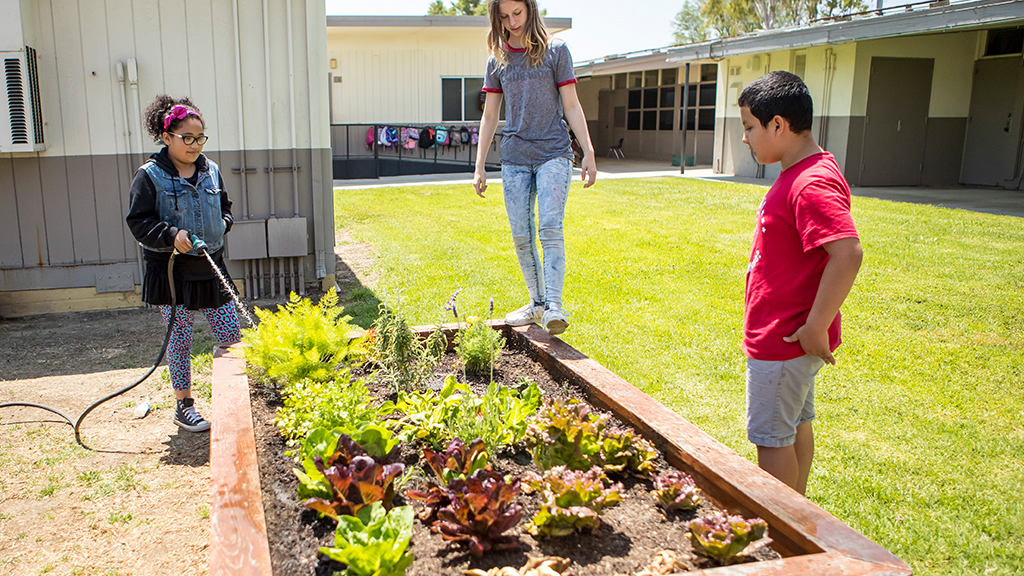
The program increased the number of mainstreamed students. PHOTO CREDIT: LOWELL JOINT SCHOOL DISTRICT
Lowell Joint School District is committed to ensuring its students with disabilities receive the best education it can offer in the least restrictive educational environment. The Special Education Blue Ribbon Action Team was established in the 2016-17 school year. The team uses data to drive and guide the program toward its goals of meeting the needs of students with disabilities.
The team believes that when all students are engaged and challenged in the least restrictive learning environment, they can reach higher academic achievements, have better school attendance, require less discipline, and discover a place to connect and belong. The team is made up of passionate, professional, and well-respected district educational leaders, and instructional leaders from Biola University, the Special Education Local Plan Area, and the county Department of Education.
Removing barriers: Students with disabilities have a wide range of academic, behavioral, and social/emotional needs that can cause them to fall behind if not discovered and supported. The district’s student achievement data demonstrates significant growth patterns over the past four years. There has been an increase in the number of students mainstreamed along with their age-appropriate peers: 114 were not mainstreamed in 2015, and now that number is four.
The special education director transitioned the special education transportation system from buses to taxi cabs. The certified and specially trained taxicab drivers provide vulnerable students with safe transportation that is equipped with air-conditioning and video security. It reduces student travel time from an average of 30 minutes down to seven to 10 minutes. This service has reduced the annual special education transportation costs from $360,000 to $80,000. The entire process ensures that every student’s quality of service counts.
The same approach was taken in the development of the Mod-Severe Medically Fragile program/class and the Applied Behavior Analysis program/class. By developing its own in-house program with highly qualified staff, the district has been able to provide high-quality instructional programs that meet the individual needs of students closer to their homes and within their homes.
Evidence of success: The program is in its fifth year. The team’s hard work to strengthen and enrich the overall program is making a positive difference in the lives of the district’s most academically and medically fragile students. The team instigated a review, research, and rewrite of all board policies and administrative regulations related to special education, the Student Study Team, and the 504 process. It also reviewed and redrafted all IEP assessments and IEP protocols. It created a staff development “Special Education 101” series.
Contact
Jim Coombs, superintendent
jcoombs@ljsd.org
www.ljsd.org
McDuffie County School System
Thomson, Georgia
Workforce and Education Initiative

Students work in a state-of-the-art welding lab. PHOTO CREDIT: MCDUFFIE COUNTY SCHOOL SYSTEM
In a district in which 100 percent of students are eligible for free meals, high school students were unaware of the job opportunities in the area. Local industries were similarly uninformed of the district’s Career, Technical, and Agricultural Education (CTAE) program.
The Archway Partnership is a collaboration among the school district, the University of Georgia, city and county governments, University Hospital McDuffie, Augusta Technical College, Georgia Power, and Jefferson Energy.
District leaders listened to the industry professionals describe their workforce needs. The Archway Partnership contributed expertise and support for two key projects: The JumpStart program and the opening of a welding lab. JumpStart was a rebranding of the district’s Youth Apprenticeship Program, which was not well-known in the community.
JumpStart is designed for CTAE pathway students. Industry leaders, including alumni, held a kickoff for juniors and seniors. A Jumpstart Career Expo allowed students to meet directly with industries interested in employing apprentices or willing to offer internships.
Another workforce initiative was the opening of a welding lab. Industry representatives expressed a dire need for welders, who earn substantial starting salaries. Industry donations, state grants, and special sales tax income were employed to construct a state-of-the-art lab.
Removing barriers: The partnership’s emphasis on workforce development aims to remove barriers to achievement and postsecondary employment for all students, particularly those who are economically disadvantaged. Recognizing that many students elect not to attend a four-year university, the partnership provides opportunities for immediate employment after high school.
The partnership has enhanced the existing relationship between the Thomson-McDuffie Chamber of Commerce, the chamber’s Forward McDuffie initiative, and local industries by encouraging students to pursue high-demand, high-wage careers that do not require four-year degrees.
Evidence of success: The number of students enrolled in work-based programming increased (267 enrollments in 2019-20, including 79 in the JumpStart program), and several were hired for spring break internships and full-time postgraduation employment. In addition, businesses donated to the construction and technology programs to grow future employees. Augusta Technical College committed to launching a manufacturing pathway in support of local industries. Partnership connections prepare students for robust postgraduation employment.
McDuffie County School System’s pathway completion rate, which includes CTAE, advanced academics, and fine arts students, was 77 percent in the 2019 College and Career Ready Performance Index (CCRPI) report, an increase from the 2011 rate of 29.5 percent. In the past three years, the number of students participating has grown from 30 to 59, with 260 course enrollments in the 2019-20 school year. In addition, the 2019 four-year cohort graduation rate of 82.19 percent was the highest since 2014.
Contact
Lynn Cato, director of curriculum and instruction
catol@mcduffie.k12.ga.us
www.mcduffie.k12.ga.us
Norton Public Schools
Norton, Massachusetts
Priority One: Social-Emotional Learning
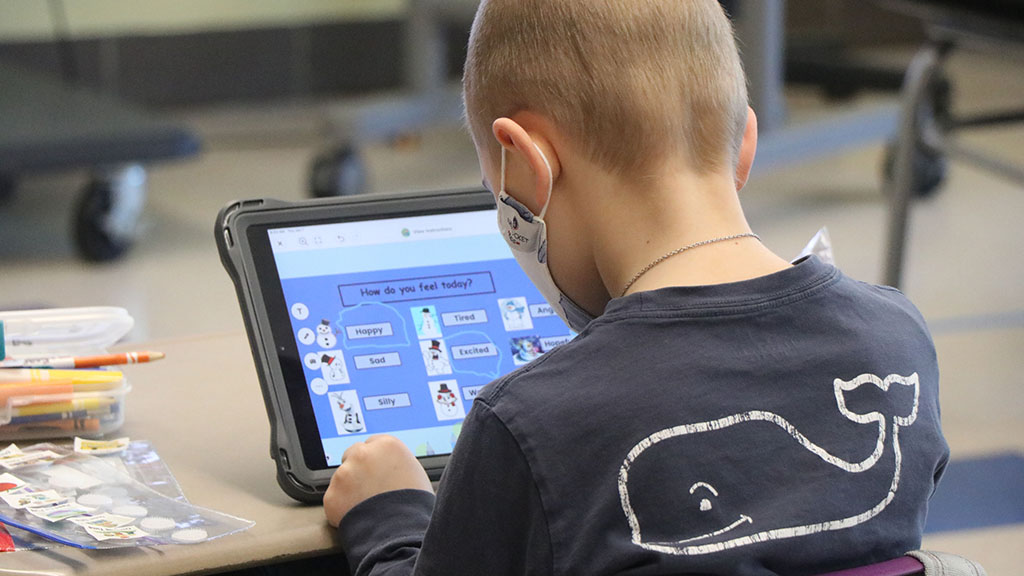
Students start their morning by saying how they are feeling. PHOTO CREDIT: NORTON PUBLIC SCHOOLS
The Norton School Committee and administration, in conjunction with the teachers association, co-sponsored and supported the Social-Emotional Learning (SEL) initiative. The rationale was simple: Strong minds will lead to success in the classroom and life. In supporting this priority, the district spent a full academic year working through a task force.
The Social-Emotional Task Force consists of three working groups. The Data and Information Committee gathered student, teacher, and parent survey data at the district level. This data supported the School Culture and Climate Committees at each school. The third piece of the triangle was the Social-Emotional and Behavioral Learning Advisory Committee that uses the information from the other two committees to improve the academic, civic, social, and co-curricular opportunities for students via a system that supports both equity and equality.
After collecting survey data via a Panorama Survey from students, parents, and staff, the district held a full day professional development session with the task force. The outcomes included the creation of action subcommittees, including SEL framework, professional development, curriculum, and best practices.
Removing barriers: Administration and staff engaged in districtwide book studies (Lost at School by Ross Greene and Culturize: Every Student. Every Day. Whatever It Takes. by Jimmy Casas). This was an opportunity for staff to look at students who struggle from a different perspective. The School Culture and Climate committees were established in each building to ensure school and district values were upheld. The district implemented the Positive Behavior Intervention System, Social Thinking, Zones of Regulation, Responsive Classroom, Strong Kids, Second Step, and lunch bunch groups across the district.
Examples of various activities in the middle school included: Zones of Regulation, Social Thinking, Lancers LEAD, lunch bunch groups.
Examples of various activities in the high school include school-to-career opportunities, Unified Physical Education, Unified Sports, new student orientation and student council mentor program, and Safe Choices assemblies.
Evidence of success: Student survey data shows improvement in how connected they are to school, how they view their teachers, and how they view the future. Attendance has improved for struggling students by more than 30 percent. Disciplinary reports show a decline in office referrals across the district. Grades have improved, with more students in the honor roll level. Significant improvements have been seen in the BRIDGE Program, which helps hospitalized high school students return to school. Many students are academically above average but struggle with mental health issues.
Contact
Joseph F. Baeta, superintendent
jbaeta@norton.k12.ma.us
www.norton.k12.ma.us
Teton County School District
Jackson, Wyoming
Community + Recreation = Enrich Student’s Time
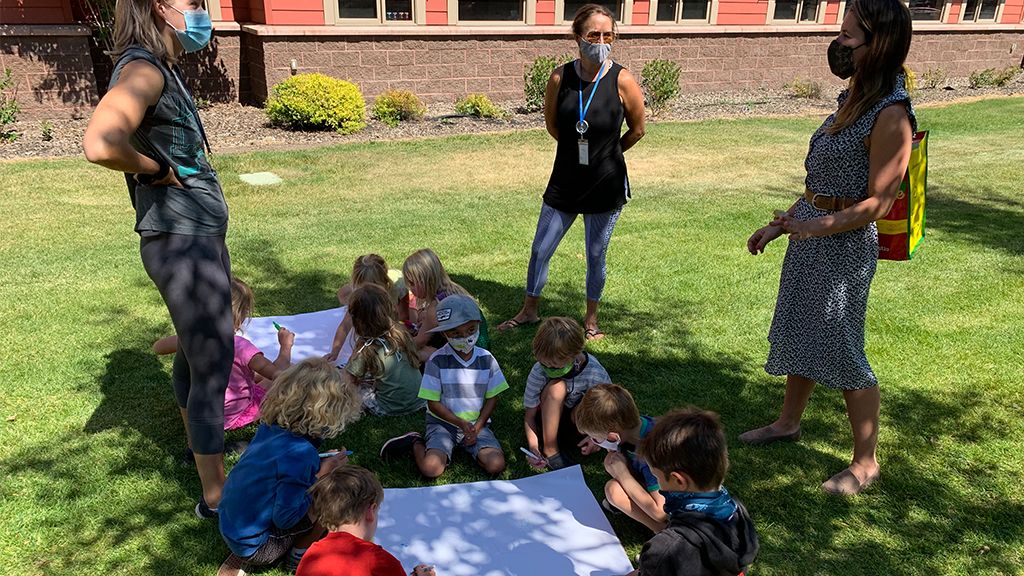
Students and teachers at a community park. PHOTO CREDIT: TETON COUNTY SCHOOL DISTRICT
In 2016, Teton County School District recognized that staff needed more structured professional development time that was independent from the end of school days, while limiting the amount of instruction time missed by students.
The district serves the area around the Grand Teton and Yellowstone national parks. Tourism is the major industry. The local service employees work multiple jobs. While having an in-service day allowed the district to provide structured professional development, it also meant that some parents were leaving children unattended while they worked or were losing pay to take a day off.
“Community + Recreation = Enrich Student’s Time” or CREST was the answer. It offers children the opportunity to learn from professionals and local community partners and participate in project-based learning on in-service days. The district expanded CREST opportunities to every Friday during the pandemic so students can engage in enriching activities at school while the community continues to provide access to unique programs. The district also added explicit instructional time to these expanded Friday CREST days so that students could engage in synchronous and asynchronous learning sessions.
Removing barriers: Teton has the highest average income per capita of any county in the U.S., at $252,000. This was partly attributed to the high incomes of Jackson Hole residents. Given the statistics of having the highest average income per capita, the highest cost of living in the country, and the reliance on the lowest wage-earning industry of tourism, there is a large disparity between the opportunities of some students. Many Teton families have never gone to the national parks in their backyards, have never seen the world-renowned National Museum of Wildlife Art of the United States, visited the National Elk Refuge, attended a live performance at the Center for the Arts, or explored the Bridger-Teton National Forest.
The opportunity gap is best seen during holidays and breaks when some families take private planes to their vacation homes while other students watch younger siblings while their parents work multiple jobs in the service industry.
The CREST program is designed to support families whose parents need to work and yet want engaging opportunities for their children.
Evidence of success: Originally designed for only a handful of in-service days each year, this year the program was expanded to every Friday due to COVID protocols.
The success is evident in the number of student participants each week, the support of community providers who are committed to engaging activities, the increase in remote learning objectives completed, and supervised children who are in a safe, healthy, and caring environment.
Contact
Gillian Chapman, superintendent
gchapman@tcsd.org
www.tcsd.org
5,000 to 20,000 enrollment
Longview ISD
Longview, Texas
Public Montessori

Montessori students explore in their science lab. PHOTO CREDIT: LONGVIEW ISD
After the lifting of a 1970 federal desegregation order in 2018, Longview ISD developed a plan to ensure equitable access to education opportunities. During an August 2018 meeting, the board of trustees unanimously voted to adopt a Voluntary Desegregation Plan for magnet school programs. In response to a strong community desire, the board focused magnet school expansion on four areas: STEAM, International Baccalaureate, Early College High School, and expansion of Montessori Education.
Longview ISD has used the Montessori style for early childhood students for more than 15 years. In 2019, the board voted to move the one remaining traditional campus to Montessori, taking the program districtwide.
“Montessori at LISD is different from the typical Montessori school because we are within a public school setting, said Jacqueline Burnett, director of East Texas Montessori Prep Academy. “We serve a diverse population, both racially and economically disadvantaged, free of charge.”
In the Montessori Method, students learn via a natural process that develops spontaneously. It educates with experiences every child has in reaction to the surrounding environment. Teachers arrange for cultural activity and interaction in a learning atmosphere tailored for each child.
Removing barriers: Creating a public Montessori campus allows all students to receive a premier and sought-after education that, normally, has only been made available to those who can afford to pay expensive tuition fees.
Superintendent James Wilcox explained that, while Longview ISD is no longer under the direct federal oversight, the district “will continue to ensure all of Longview’s students have fair and equitable access to our best educational opportunities.”
Wilcox said the voluntary desegregation plan is designed to support the district’s efforts to provide instruction and experiences that integrate students of different backgrounds together, remedy the separation of minority students in one or more schools within the district; prevent, reduce, and eliminate social, racial, ethnic, or economic isolation; ensure equal educational opportunity and access for all students; and cultivate student integration and diversity.
Evidence of success: In 2019, Longview received 40 state distinctions, proving that district teachers and the Montessori education platform are making a difference in those who are moving into the testing grades.
In 2018, the board approved the use of districtwide the Iowa Test of Basic Skills to track gaps and growth of students. The scores also are used to identify students for the district’s Gifted and Talented (GT) program and acceptance into the award-winning Hudson PEP Elementary, which is an academically accelerated campus. This allows for more students to qualify for Hudson PEP and GT than may have been previously considered because of economic stereotyping or behavior status. Testing results were the highest in 10 years for minority students and economically disadvantaged students. This shows that Montessori education is positively affecting early childhood students.
Contact
Elizabeth Ross, multimedia director
eross@lisd.org
https://w3.lisd.org/
McMinnville School District
McMinnville, Oregon
Ready for Kindergarten
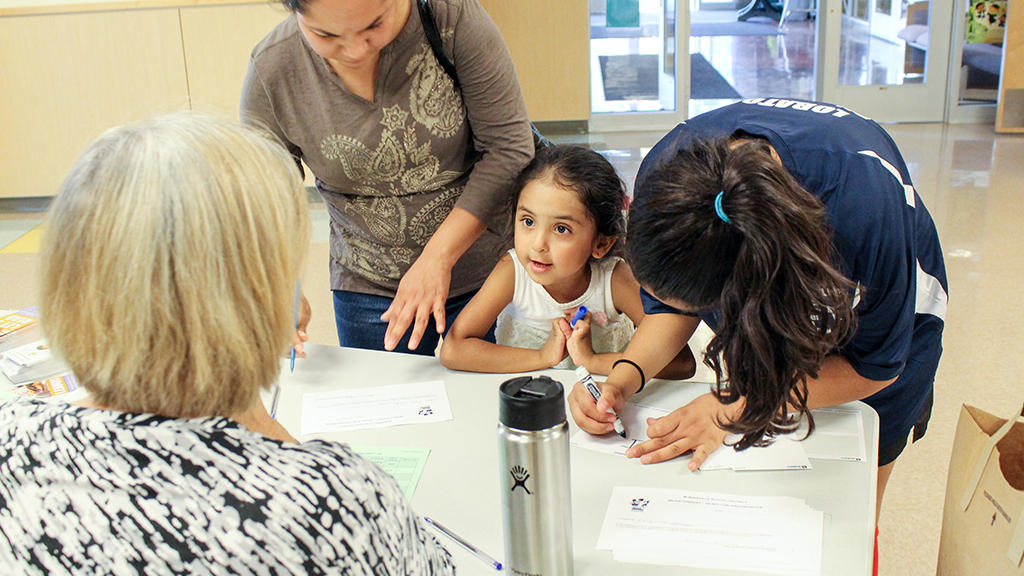
Volunteers help out with workshop registration. PHOTO CREDIT: MCMINNVILLE SCHOOL DISTRICT
McMinnville is a high-poverty district with a large Latino and English-learning population. Ready for Kindergarten is a program for children from birth to age 5. Parents attend three workshops per year (fall, winter, spring) that are focused specifically on the age of their child (birth to one, one to two, etc.). The workshops start with a communal meal and the opportunity for families to connect with one another and with community-based resources (housing, food support, utility assistance, etc.). Parents then attend the workshop focused on their child’s age and development. Workshops are offered in Spanish and English. Over 60 percent of participants are Spanish speakers. The other 40 percent are families in poverty or those who are homeless.
The workshops feature child development instruction and coaching. Each family leaves the workshop with a bag of high-quality, age-appropriate toys and books. Child care is available on-site. All Ready for Kindergarten services are free of charge to families.
Removing barriers: Early childhood education is critical for underserved and vulnerable children. By enabling parents to be their child’s first and best teacher, the district seeks to narrow the achievement gap, and data supports that belief. District Latino students, English learners, and economically disadvantaged students outperform state averages, by double digits, in reading, writing, and math on statewide assessments. These testing results are due to the investment in Ready for Kindergarten and the pre-K program for 4-year-olds who are English learners or children in poverty. The program costs approximately $20,000 per year, which is solely for materials and supplies and food. Teachers and child care workers are volunteers.
Evidence of success: Ready for Kindergarten has been operating for 10 years. Attendance is not restricted to district students but includes the entire county. English learners, students of color, students with disabilities, and students in poverty outperformed the state averages on English/language arts, math, and science statewide assessments. Students were 17.3 percent above the state average in math, 4.3 percent in English/language arts, and 4.7 percent in science on statewide assessments.
Contact
Jill Long, grant writer/administrator
jlong@msd.k12.or.us
www.msd.k12.or.us
Pendergast Elementary District
Phoenix, Arizona
ASU Prep Digital Program

Middle school students can earn high school credits. PHOTO CREDIT: PENDERGAST ELEMENTARY DISTRICT
The Pendergast District school board was concerned that middle school students did not have the opportunity to earn high school credit for math and English. As a K-8 school district, Pendergast does not have high school teachers or accredited high school curriculum readily available for students or staff. Students who qualify and are interested in advancement don’t have opportunities to get a head start on their high school coursework. The director of curriculum was tasked with researching programs from which students would benefit. The district chose ASU Prep Digital based on its track record for success, individualized programs, support systems for the students, and its credibility and accountability.
ASU Prep Digital is an accredited, online school where students can take a single online course or enroll in a full-time, diploma-granting program. Part of Arizona State University, it offers an accelerated path and the chance to earn concurrent high school and college credit.
ASU Prep has highly qualified high school teachers who provide instruction in high school-level algebra, geometry, and English to identified middle school students. These students take their high school coursework during the regular school day when other students are doing interventions. The course instruction happens virtually in the libraries when school is in session, and currently via Zoom during distance learning due to COVID-19.
Removing barriers: Pendergast is a low-socioeconomic district that is 90 percent diverse. To remove any barriers to academics, the district sought to convince students that they are fully capable of doing high school work and being successful at it. This structured programming allows students to have access to highly qualified teachers that the district couldn’t otherwise afford. By providing high school coursework, the students have access to the same opportunities available to students in more affluent areas. Being able to get a head start on their high school coursework allows the students to make room in their high school schedule for dual enrollment, AP, and CTE courses. If they didn’t take classes during middle school, students would have to attend summer school to try to get ahead in their high school coursework. Many students must work during the summer to provide financial support for their household, so this option would not be open to them.
Evidence of success: The ASU Prep Digital Program is in its fourth year. Each year, approximately 150 middle school students have participated in the program. All students who took geometry passed the course, and 96 percent of students participating in algebra passed the course. Also, 90 percent of students participating in English passed the course. Due to COVID-19, students completed their coursework remotely from home.
Contact
Nedda Shafir, communications consultant
nshafir@pesd92.org
www.pesd92.org
Reading School District
Reading, Pennsylvania
College Level Examination Program
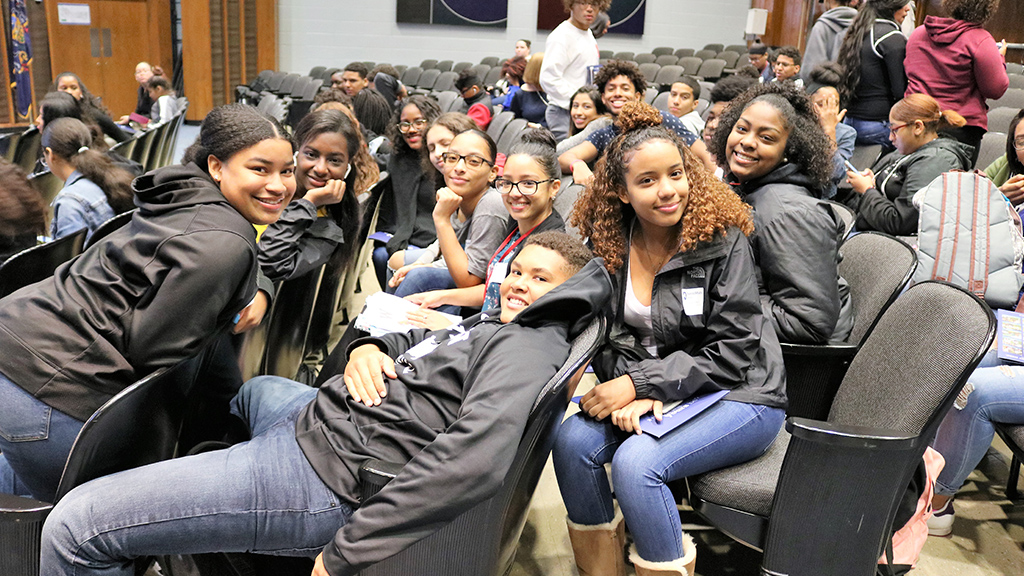
Students earn college credits for their language knowledge. PHOTO CREDIT: READING SCHOOL DISTRICT
Reading School District is a Title 1 urban district located in a high-poverty community, where 93 percent of students qualify for free or reduced-price meals, 25 percent of students are English learners, and 18 percent receive special education services. Students represent 28 different countries and speak 27 different languages.
Through the district’s support of the College Board’s College Level Examination Program (CLEP), students can earn college credits while still in high school using their existing knowledge. Reading School District offers information to students on how to use this method to bypass introductory college classes and how to prepare for the exams. The district pays for students to take the test, and college partners waive fees and provide college visits and orientation programs.
Removing barriers: CLEP uses students’ mastery of languages as a cultural resource to promote motivation, access, and affordability to higher education. It is a rigorous program that allows students from a wide range of ages and backgrounds to demonstrate their mastery of introductory college-level material and earn college credit. The district uses it to allow underserved students to access college credit-granting courses. In particular, French and Spanish native speakers see the benefits.
Evidence of success: CLEP has a 100 percent success rate for Reading students. The program was originally instituted in 1997. Since then, every year about 80 to 100 high school seniors have taken, passed, and earned six to 12 college credits. Some of the additional benefits of CLEP are higher GPAs, better course performances, increased likelihood of high school and college degree completion, high college retention rates, shorter time to college degrees, and significant cost savings.
The district’s budget for the test is around $9,000 per year. The market value of the total number of college credits earned surpasses the $200,000 figure. This minimum investment is worth the great return. Reading views CLEP as a scholarship given to students as an incentive to go on to college.
Contact
Lisa Iezzi, board secretary
Iezzilm@readingsd.org
www.readingsd.org
Over 20,000 enrollment
Cumberland County Schools
Fayetteville, North Carolina
Mentored Next Steps in Equity

Several projects focused on LGBTQIA cultural awareness. PHOTO CREDIT: CUMBERLAND COUNTY SCHOOLS
Mentored Next Steps in Equity was launched from a six-week workshop, “What’s Going On with Our Country,” which discussed Black Lives Matter protests over the summer, the symbolism of the Confederate flag, and the historical roots of racial inequity. Participants asked, “What can I do?” Mentored Next Steps in Equity creates an opportunity for district educators to further the work of equity.
Participants create a plan of action and then carry out their own equity project. They are paired with an equity mentor who has been engaged in school or district equity work. Cumberland County’s Equity Leads also help the participants meet their goals. Together, the mentor and Equity Lead assist participants in devising their plans and in moving forward. They offer guidance, constructive criticism, networking suggestions, and at times, a push to keep moving forward. Each cohort lasts a semester.
Projects run the gamut. Several principals, assistant principals, and teachers are creating equity teams at their schools and are conducting equity professional development for their staff. Three participants focused on LGBTQIA issues. Their work ranges from personal awakening/claiming their identity with no shame to creating LGBTQIA cultural awareness professional development for teachers and students at their school. One teacher is expanding a program that increases access of students of color and other underserved students to honors and AP courses within the county. A media specialist is working to reach African American students in her practice. She has written and received a grant for funds to purchase more print materials by African American authors or with African American protagonists.
Removing barriers: This program offers a novel way to approach equity by giving participants the freedom to innovate and the support to carry out their projects. These projects must have an equity-based goal that ultimately impacts students in a positive, affirmative manner. Some of the ways in which these projects do that is through the creation of equity teams that conduct equity audits and seek appropriate solutions; provide equity-centered professional development for colleagues to dispel implicit biases and improve their practice; increase the capacity of teachers and staff to better serve those students who tend to slip through the cracks; and empower students to advocate for themselves, particularly when they are part of an underrepresented group.
Evidence of success: The success of Mentored Next Steps in Equity can be seen in the implementation of the various projects that are organic, sustainable, and produce results. Because the initiative is participant-driven, it moves forward through the motivation of the participants to meet their equity goals. The projects are enthusiastically maintained. The program has the seeds of success within itself because the participants are self-selected and passionate to move forward on an equity issue.
Contact
Jovan Denaut, integrated academic and behavior support facilitator
jovandenaut@ccs.k12.nc.us
http://ccs.k12.nc.us
Cumberland County Schools
Fayetteville, North Carolina
Equity-Focused Classroom Management

Teachers participate in an equity class. PHOTO CREDIT: CUMBERLAND COUNTY SCHOOLS
For years, Cumberland County Schools has offered a classroom management intensive course. It became apparent that the course needed to be reimagined to meet the challenges of diversity. The district contains a wide range of ethnic/racial, religious, economic, and sexual orientation/gender identity diversity in both the student and staff populations. With so many demographic variables, teachers needed specialized, intensive classroom management training to best serve such a diverse population of students. This course is designed for new teachers (particularly those who did not attend a teaching program), struggling experienced teachers, and teachers new to the county.
The course provides in-depth analysis and application of classroom management theory with a focus on practices that promote equity in the classroom. Participants explore the influence of race, ethnicity, poverty, differing abilities, and diversity and how these variables impact their students and their classrooms. This course helps teachers discover their implicit biases and begin to dismantle them. They learn how to apply resilience theory, conscious discipline methodology, behavioral management, multitiered systems of support and intervention, and the latest discoveries in brain research to create an effective and enjoyable learning environment for their students.
The instructors are equity-focused professional development teacher-leaders who have at least 10 years of experience in the classroom and have demonstrated high levels of effectiveness in reaching all their students, particularly their students of color and disadvantaged students. They have received extensive training in implementing sustainable equitable practices in the classroom.
Removing barriers: One of the biggest barriers to student achievement is, of course, the teacher. Many variables—such as the teacher’s mindset, skill, and ability at forging and maintaining authentic relationships with students that may not look like her, ability to create a positive learning environment, facilitate active engagement, and make the learning meaningful—are integral to student success. This course is an opportunity for teachers to receive intensive, focused instruction in how to develop and maintain authentic, healthy relationships with their students and create positive learning environments.
Evidence of success: Teachers who have taken this course have fared much better in their classrooms and are more effective than those who have not. Success can be seen, also, in teacher and administrator feedback as to the effectiveness of the program.
Contact
Jovan Denaut, integrated academic and behavior support facilitator
jovandenaut@ccs.k12.nc.us
http://ccs.k12.nc.us
DeKalb County School District
Stone Mountain, Georgia
Parent and Family Engagement IMPACT
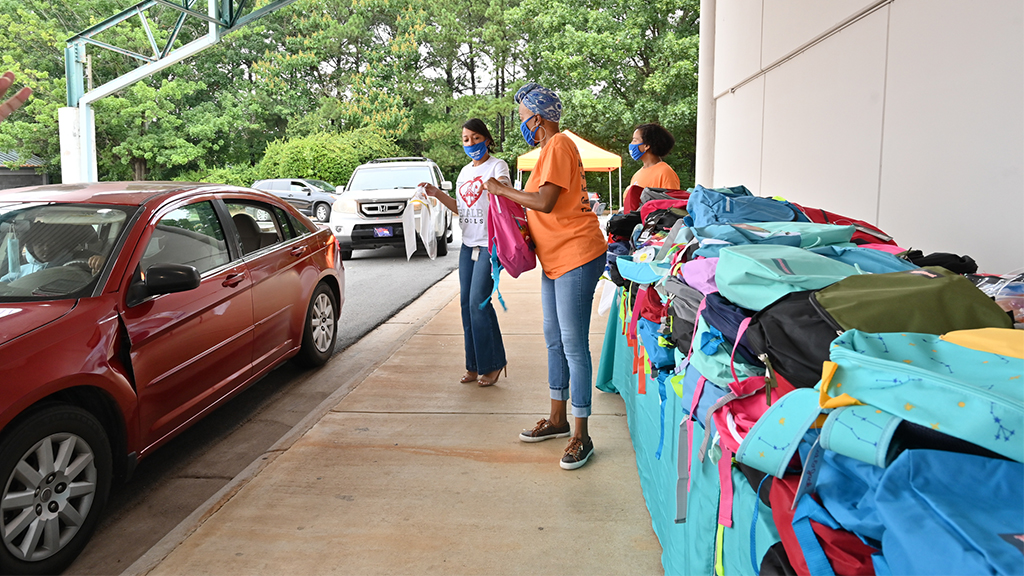
A back-to-school drive thru gives out food and backpacks. PHOTO CREDIT: DEKALB COUNTY SCHOOL DISTRICT
DeKalb County School District’s Family IMPACT Model for parent’s personal and professional growth and development has expanded service beyond Title I student academic support and compliance. Parental and family engagement is the nucleus around which all other stakeholder engagements revolve. The focus of the work is Involving and Motivating Parents to be Active Contributors over Time (IMPACT). The team is dedicated to addressing the most exigent areas of need that affect how, when, and where parents become involved in the advancement of students.
The Family IMPACT Hub serves as the epicenter for service to families. This state-of-the-art facility is where staff develops and implements districtwide programs and initiatives. The program includes three components.
The Parent Health Ambassador Program (PHAP) is a partnership between the county board of health and the district that educates parents on health and well-being policies. The Parent Leadership and Advocacy focus area provides parents and caregivers with information on student achievement, the workings of the school system, and skills in advocacy and educational support.
The Parents as Leaders (PALs) Program is a tiered leadership development program for parents and caregivers to build capacity to support the academic success of their children.
The Family Friendly School initiative has been developed to help schools create and maintain a positive learning climate that is friendly, inviting, and culturally sensitive.
Removing barriers: The district’s mission of supporting all families to be more involved in supporting their student’s academic career and staying informed about what children are learning in class has become its overarching strategy for improving learning and addressing the achievement gap. Workshops for parents on navigating the school system, active parenting, and learning how to assist their children at home help parents understand the important role they play in their children’s learning and how it is linked to higher reading and math scores.
Evidence of success: The district has seen major shifts in the number of parents and caregivers participating in surveys, workshops, conferences, and town halls since the program started three years ago. A record number of parents sign up to participate in activities. The GED program support started with 20 parents and to date has risen to 1,477.
The district has seen improved parent-teacher relationships and improved school environments through efforts to help schools become more family-friendly. Through wraparound services for families and consistent messaging about self-care and trauma-informed care, the district has seen increases in emotional and behavioral strengths and improved relationships among students and their peers.
Contact
Marcia Coward, district family engagement manager
marcia_coward@dekalbschoolsga.org
http://dekalbschoolsga.org
Ysleta ISD
El Paso, Texas
Academic Language Programs
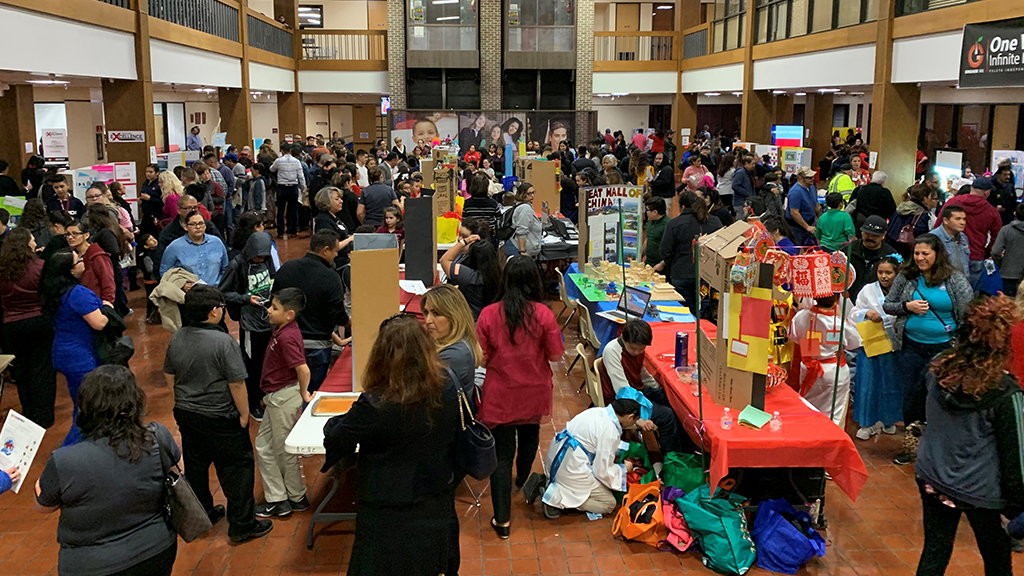
Students showcase their Spanish language knowledge. PHOTO CREDIT: YSLETA ISD
In Ysleta ISD, one in every four students is identified as an English learner (EL). The district is in far west Texas on the Mexican border. Students cross the border to attend school Monday through Friday and then return to Mexico to reunite with family on the weekends. The Academic Languages Program goes far and above the state bilingual instruction requirements for ELs. It has resulted in gains in English proficiency, cultural awareness, and the development of true bilingualism and biliteracy.
In the elementary grades, the district runs a 90/10 model with English and Spanish. Beginning in third grade, students use their English language arts to support growth and language proficiency, use Spanish language arts to support Spanish academic language growth, and use social studies standards to support multicultural awareness.
In middle school, students either continue on the English as a Second Language (ESL) path or choose a biliteracy acknowledgment path. In the biliteracy acknowledgment path, the focus is on college readiness. Students can take Advanced Placement (AP) and dual credit courses. Some of these courses are taught in Spanish, aligned to the Career and Technical program, and even part of the Early College High School programs. Both pathways continue in high school through graduation.
Removing barriers: The program is designed to accelerate social and academic language acquisition while simultaneously building content area knowledge and skills for all ELs. The program uses an integrated approach to instruction of content area and academic language knowledge and skills, data-driven instruction, and a commitment to teaching the whole child.
Evidence of success: The program exhibits two critical characteristics of successful programs: consistency and sustainability. The dual language component traces its roots back to the early 1990s with the development of the dual language program and the subsequent opening of the district’s first dual language school. The program transitioned in 2015 from language proficiency development in isolation to a program where academic language and content area knowledge and skills are developed simultaneously.
Students have achieved high levels of success on several data sources that show growth in both academic and language acquisition that exceeds state averages. Their performance on state assessment programs for content area knowledge and skills (STAAR) and social and academic language acquisition (TELPAS) support this claim. Recent results show that Ysleta ELs had higher passing rates (70 percent) in all tested content areas in all grade levels than all Texas ELs (63 percent).
Contact
Louisa Aguirre-Baeza, director of academic language programs
lbaeza4@yisd.net
www.yisd.net

Share this content